Marina Abramović was born on November 30, 1946 in Belgrade Serbia ,(then Communist Yugoslavia). She graduated at the Academy of Fine Arts in Belgrade in 1970 and completed her post-graduate studies at Zagreb Academy in 1972. She taught at the Academy of Fine Arts, Novi Sad, from 1973 to 75 while preparing her first solo performances. She moved to Amsterdam in 1976 and has lived in New York since 2001.
She had a very unusual and strict upbringing. She lived with her very religious grandmother until the age of six while her mother furthered her career in the Communist regime. In an interview published in 1998, Abramović described how her “mother took complete military-style control of me and my brother. I was not allowed to leave the house after 10 o’clock at night till I was 29 years old. … All the performances in Yugoslavia I did before 10 o’clock in the evening because I had to be home then. It’s completely insane, but all of my cutting myself, whipping myself, burning myself, almost losing my life in the firestar, everything was done before 10 in the evening.“ Quoted in Thomas McEvilley, “Stages of Energy: Performance Art Ground Zero?” in Abramović, Artist Body, [Charta, 1998]. https://en.wikipedia.org/wiki/Marina_Abramovi%C4%87.
In 2011, she turned what amounted to an abusive upbringing into a stage production called the Life and Death of Marina Abramović in which she played both herself and her mother. She spent many years criticising the repressive nature of her family and her country through her performances.
One instance is her “Freeing” series where Abramovic let herself go completely. In Freeing the Body, she wrapped her head in a black scarf and danced frenetically to the rhythms of a bongo drum – until she collapsed in exhaustion. In Freeing the Voice, she lay prone on a mattress and howled for three hours, till she lost her voice. In the last event, Freeing the Memory, she uttered every word she could think of continuously, for 50 minutes, many of which have Stalinist associations. However, although her mother “ was incredibly cold.. the Communist discipline and iron will-power she instilled made me the artist I am.” Article by Alastair Smart dated 21 September 2014 in http://www.telegraph.co.uk/culture/art/11109674/Has-Marina-Abramovic-betrayed-her-past-or-fulfilled-it.html
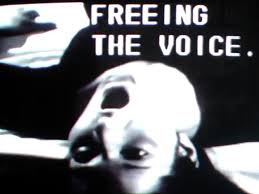
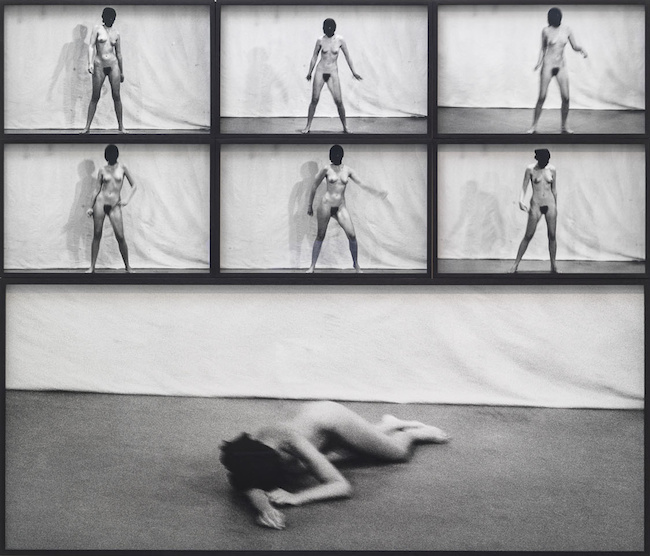
Freeing the body
She is a performance artist whose work explores the relationship between performer and audience, pain and the power of the mind and limits of the body. Since the late 1950s, many artists had become interested in performance art as a substitute for abstract art which had started to lose popularity but Marina Abramović’s work is typical of the aims of the new generation in her eagerness to avoid traditional art materials such as paint and use her own body as medium. From the beginning, pain, suffering and endurance were central to Abramović’s art. She pioneered the involvement of observers in her work, focussing on “confronting pain, blood, and physical limits of the body.” emaria, Cristina (August 2004). “The Performative Body of Marina Abramovic”. European Journal of Women’s Studies 11 (3): 295.
She pushed herself beyond her physical and mental limits––and at times risking her life in the process––and created performances that challenge, move and shock us. Despite the emphasis on pain in her performances, Abramovic claims she is not masochistic. To her, pain is a way of accessing the subconscious and the power of her mind. “In every culture, [there are those] shamans or medicine men who endured incredible physical pain, because it’s a door opening to the subconsciousness. And the way we can actually control the pain – it’s how to control everything. This is the key.” Marina Abramović: 512 Hours is at The Serpentine Gallery, London W2, from 11 June to 25 August.
Seductive, fearless, and outrageous, Marina Abramović has been called “the grandmother of performance art” and has, through her forty years of performance, redefined what is meant by the term “art”. Although she is now a world-wide icon, Abramovic was poor and unknown in the art world for decades. She lived out of a van for the best part of 10 years with her -partner Ulay, with whom she collaborated in the seventies to create performances that explored dualities such as male and female, active and passive, through repetitive, exhausting, and often painful actions. Through these performances she discovered the power of self will, “that you can do anything if you set your mind to it.”
She was once asked by an arts critic to define the difference between theatre and performance art. For her, the difference is that theatre is always fake and the emotions not real whereas with performance the opposite is true – the knife is real, the blood is real and the emotions are real. In her 40-odd years as a performance artist, Abramović has dealt in what she calls “true reality”, often at great physical and psychological cost.
Her art is deeply anti-materialistic. It is hard to package and sell performance art, which is why she was drawn to it in the first place. The nearest you can get is video or photographic stills of her now iconic shows. Abramović’s performances have often been about duration and endurance, suffering, not exactly something it’s easy to buy or sell. It’s hard to commodify stabbing yourself or burning your hair and nails in a fire. What’s there to purchase? In some ways, this explains why some critics still are reluctant to consider her performances as art.
Her main performances include :-
Lips of Thomas 1970s, named after a lover of hers, which involved her whipping herself, cutting a five-pointed communist star – a recurring motif in her work and a monstrously sly up yours to the regime – into her own abdomen with a razor blade, and then lying on a cross made of ice beneath a suspended heater for 30 minutes, bleeding all the while.

Rhythm 10, 1973 in Edinburgh where she aimed knives between the splayed fingers of her hand. Each time she cut herself, she picked up a new knife from the row of twenty she had set up, and recorded the operation. After cutting herself twenty times, she replayed the recording and attempted to replicate the sequence exactly. This performance made her aware that in the performance state of mind “ you can push your body to do things you absolutely could never normally do.” https://en.wikipedia.org/wiki/Marina_Abramovi%C4%87#cite_note-8
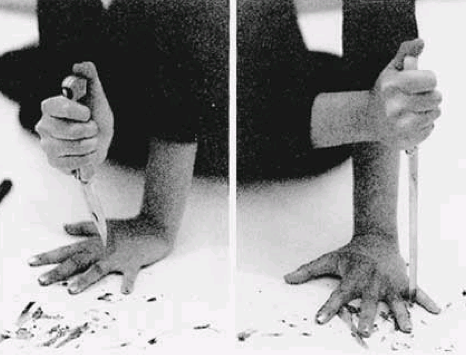
Rhythm 5, 1974. In this performance she used a large petroleum-drenched star which represented communism and the traditions of her past. She lit the star at the beginning of the performance and threw herself into its burning centre. Unfortunately, she lost consciousness due to lack of oxygen and almost died. Abramović later commented that this experience made her angry as it proved that there were physical limits to any act – to lose consciousness is to lose control of your mind and your will.

Rhythm 0, 1974. This is one of Abramovic’s most challenging and best-known performances. In it she played a passive role with the public taking the active. 72 objects were placed on a table for people to use against her body in any way they chose. Some of these objects, such as a feather, honey and a rose, could give pleasure. Others, however, included a whip, scissors, scalpel and a loaded gun which could inflict pain and could maim. For six hours Abramovic allowed the audience to manipulate her body and actions to test how vulnerable and aggressive people can be in circumstances with no social consequence.
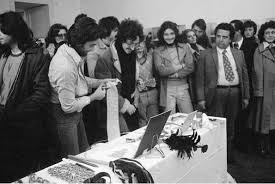

Initially, members of the audience reacted with caution and modesty but Abramović soon exposed a savagery lurking beneath the surface of otherwise civilised human beings. As time passed, and the artist remained passive, people began to act aggressively. As Abramović described it later: “What I learned was that… if you leave it up to the audience, they can kill you. …I felt really violated: they cut up my clothes, stuck rose thorns in my stomach, one person aimed the gun at my head, and another took it away. It created an aggressive atmosphere. After exactly 6 hours, as planned, I stood up and started walking toward the audience. Everyone ran away, to escape an actual confrontation.” She was frightened by the experience and resolved not to take such chances again. https://en.wikipedia.org/wiki/Marina_Abramovi%C4%87#cite_note-13
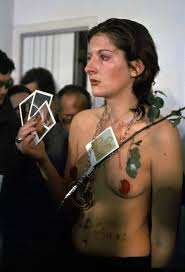
Cleaning The Mirror, 1995. Cleaning the Mirror consisted of five monitors playing footage of Abramović vigorously scrubbing a grimy human skeleton in her lap with soapy water. As the skeleton becomes cleaner, Abramović becomes covered in the greyish dirt that was once covering the skeleton. This three hour performance recalls ancient Tibetan death rites that prepare disciples for their own mortality. “The work is really about facing your own mortality. It’s something that in our life we fear the most. It is about fear of pain and fear of dying.” http://zoowithoutanimals.com/2013/11/18/nude-with-skeleton/ and http://abramovic.garageccc.com
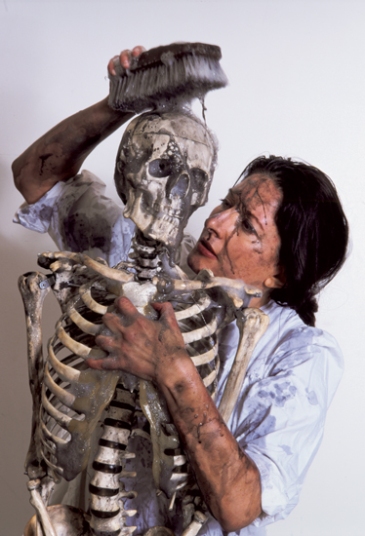
Collaborations with Ulay (Uwe Laysiepen). During the decade of their collaborative work Abramovic and Ulay decided to join together to form a collective entity called “The Other”. They dressed and behaved like twins and created a relationship of complete trust. They slammed into each other, shrieked in each other’s faces, or sat staring at each other for interminable lengths of time to test, and conquer, the boundaries of what is endurable.
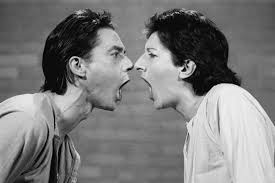
Their performances include:-
Relation in Space (1976) where they ran into each other repeatedly for an hour – mixing male and female energy into the third component called “that self.”
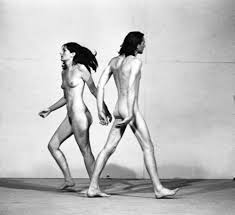
Relation in Movement where they drove their car inside a museum for 365 laps, a black liquid oozing from the car to form a sculpture. Each lap represented a year and the full number of laps represented the New Millennium.
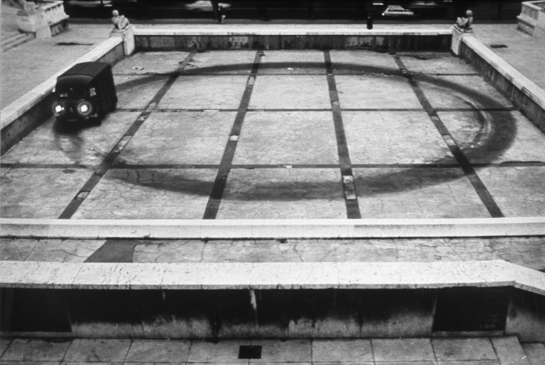
Breathing In/Breathing Out where the two used a devise to connect their mouths and took in each other’s exhaled breaths. Seventeen minutes later they both fell to the floor unconscious, their lungs having filled with carbon dioxide. This explored the idea of an individual’s ability to absorb the life of another person, exchanging and destroying it.

Imponderabilia (1977) where the two stand in a doorway completely nude, forcing the public to squeeze between them and choose which one to face.
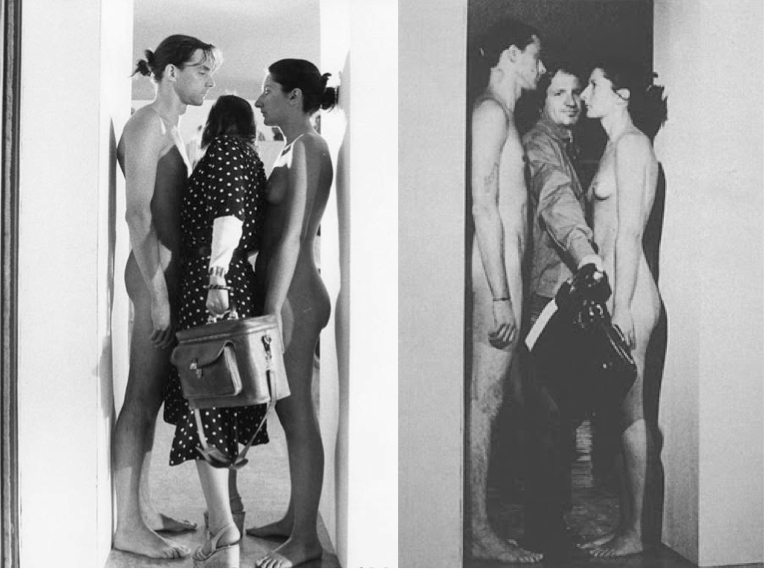
Rest Energy(1980) Dublin where both balanced each other on opposite sides of a drawn bow and arrow, with the arrow pointed at Abramović’s heart.
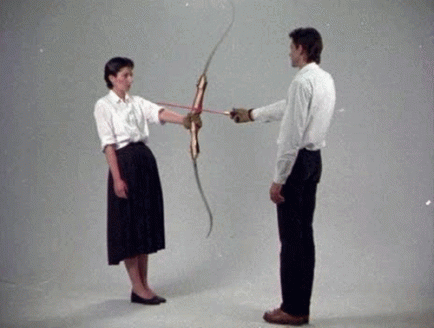
In 1988, after several years of tense relations, Abramović and Ulay decided to make a spiritual journey along the Great Wall of China Unfortunately their meeting at the mid-point signalled the end of their relationship rather than the planned marriage.

Seven Easy Pieces, 2005. Beginning on November 9, 2005 at the Guggenheim Museum in New York City for seven consecutive nights for seven hours Abramović recreated the work of five artists first performed in the ’60s and ’70s as well as her own Lips of Thomas and a new performance on the last night. The performances were arduous, requiring both the physical and the mental concentration. The performances included Bruce Nauman‘s Body Pressure (1974), Vito Acconci‘s Seedbed (1972), Valie Export‘s Action Pants: Genital Panic (1969), Gina Pane‘s The Conditioning (1973), Joseph Beuys‘s How to Explain Pictures to a Dead Hare (1965), Abramović’s own Lips of Thomas (1975) and Abramović’s own Entering the Other Side (2005). Below is her portrayal of Beuys’ and Accondi’s pieces.
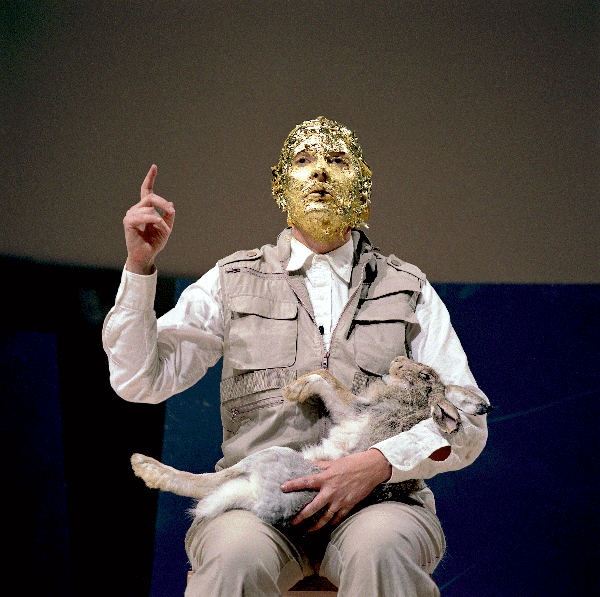
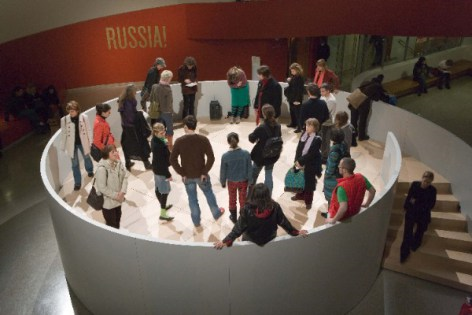
The Artist is Present 2010. The Museum of Modern Art held a major retrospective and a performance recreation of Abramović’s work from 14 March to 31 May 2010,, the biggest exhibition of performance art in MoMA’s history. During the exhibition, Abramović performed The Artist Is Present, a 736-hour and 30-minute static, silent piece, in which she sat immobile and mute in the museum’s atrium while spectators were invited to take turns sitting opposite her. Before the show opened, both Abramović and MoMA half worried that no one would turn up but soon celebrities started to drift in to sit opposite her. Some wept; others laughed. Ulay made a surprise appearance at the opening night and she was so moved to see him that she broke her immobility to hold his hands.
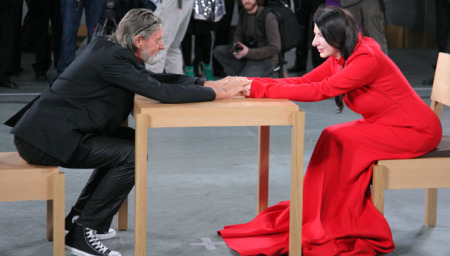
For three months, Abramovic sat there, impassive, during which time the performance drew record crowds to the gallery and became one of the most famous and controversial pieces of performance art ever staged.
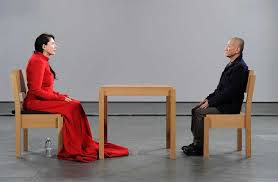
This exhibition was the high point of her career. She wanted performance art to be legitimated, and the MoMA exhibition, as she well knew, would secure that once and for all. At 63, she had lost patience with being a fringe artist. “It is one thing to be ‘alternative’ when you are 20 or 30 or 40, but excuse me, I’m 63! I don’t want to be alternative anymore”. http://marinafilm.com/.. To be given a retrospective at one of the world’s premiere museums is, for any living artist, the most exhilarating sort of milestone. For Marina, it is far more: it is the chance to finally silence the question she has been hearing over and over again for four decades: “but why is this art?”
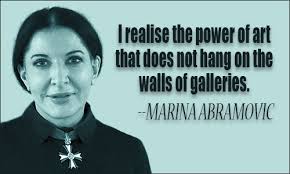
512 hours June 2014 at the Serpentine Gallery in London. This performance differed from the MoMA one in that no chair and table were provided. Instead, all day every day from 11 June to 25 August, Abramović wandered around the empty gallery where, after being asked to shed their coats, watches and all their devices, visitors were invited to come in and peer at her. “It’s the public and me and nothing else,” she says. “I took the objects away. But the encounter …” She smiles. “I’ve never done anything as radical as this. This is as immaterial as you can go.” Emma Brockes interview Monday 12 May 2014 at Marina Abramović: 512 Hours is at The Serpentine Gallery, London W2, from 11 June to 25 August.

It was a strenuous performance for her age, having to be constantly on her feet for many hours at a time. Some 120, 000 Londoners visited her, many of them queuing for hours and all of them surrendering their phones, bags and other belongings at the entrance – so as to be 100 per cent engaged. She views her art almost as a sacrificial and religious ritual, performed by her for a congregation of viewers and resulting in an exchange of energy and the exploration of concepts such as trust, endurance, cleansing, exhaustion, and departure. Despite the hardship and the mixed reviews Abramovic claims the experience at the Serpentine was incredible for all involved and well worth the aches and pains she endured.
Generator December 2014 at the Sean Kelly Gallery Nrw York where participants are blindfolded and wear sound-cancelling headphones in an exploration of nothingness. The main gallery was transformed into a space of sensory deprivation in order to encourage introspection. Visitors were required to leave their phones, watches and bags behind so as to create an uninterrupted and quiet physical and mental state. Trained facilitators were at hand to assist the visitors and help them don noise cancelling headphones and blindfolds. A maximum of sixty-eight people were allowed in at a time
 .
.
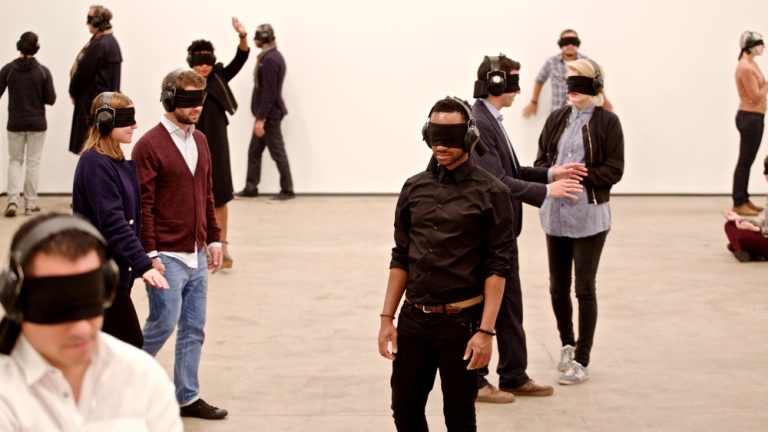
As can be seen from her MoMA ,Serpentine and Sean Kellyevents, Abramovic has transformed her performances with the encroachment of age. She still has the ability to conquer pain but now prefers to substitute duration for physical assault. “I still look at my body as a machine and I still use the mind – the will – to control what I do,” she says, “but there is something more Buddhist now about the performances …. For me, the long duration of a piece is the key to real transformation – and performance art is nothing without transformation.” Sean O’Hagan Interview on 3 October 2010 at http://www.theguardian.com/ artanddesign/2010/oct/03/interview-marina-abramovic-performance-artist.
She is also eager to safeguard her legacy as a performance artist. With a musical dedicated to her life, the success of her show at MoMA, and her appearance on Time magazine’s list of the 100 most influential people of 2014, it is clear that performance by Marina Abramović has become a mainstream activity and has become increasingly of interest to contemporary museums. However, although Abramović is clear about her own importance – “I am like a brand, like Coca-Cola, the Fulbright Foundation, Lincoln Centre, whatever you want” she is aware that the ephemeral quality of performance art is a major threat to her legacy. How you archive and retain the evidence of past performances is an issue that the Marina Abramović Institute is addressing. Its workshop is dedicated to the performance, cataloging and propagation of performance art and the teaching of the Marina Abramović method , a series of exercises designed to explore boundaries of body and mind. In the process, the Institute will serve to immortalize her name and her art. Her TED video recording can be watched at
an_art_made_of_trust_vulnerability_and_connection?language=en
https://www.youtube.com/watchv=M4so_Z9a_u0https://www.ted.com/talks/marina_abramovic_
One outstanding question still stands. Despite her popularity and her MoMA exhibition, critics still question whether or not her performances qualify as true art. For example, Richard Dorment of the Daily Telegraph said of his visit to the Serpentine that he “hated every minute of it” and was alarmed at how submissively visitors accepted Abramovic’s direction to stare at a blank wall or count grains of rice. “It was what I imagine the open ward of a mental hospital is like when the inmates are heavily sedated.” He also compared the reception to a messianic cult, as people yearned for some sort of spiritual guidance in a secular age. Abramovic received similar criticism for her show The Artist is Present in New York four years ago, yet she remains phlegmatic, insisting “if I’d listened to my critics in the Seventies, I’d never have got anywhere.” http://www.telegraph.co.uk/ culture/art/ 11109674/Has-Marina-Abramovic-betrayed-her-past-or-fulfilled-it.html
Today performance art is often seen as a joke. Although taken seriously by the art world, it is often considered pretentious and intellectually dishonest – if you are wowed by it, you are either susceptible to pseudo-intellectual guff, or lying. As one reviewer stated of the public’s reaction to Abramovic’s MoMA performance ” I think this phenomenon was one part authentic catharsis, one part media-generated hysteria, as the whole thing became a scene and people competed against each other to out-feel and out-emote each other”. https://news.artnet.com/art-world/marina-abramovic-at-sean-kelly-has-her-fame-become-an-artistic-obstacle-143848
However, there have been some powerful works of performance art – but most of them took place a long time ago, in the early 1970s, when the likes of Marina Abramovic and Chris Burden were risking all. So, what makes these performances art while others are decried? It is probably the passion, the integrity , the need to push the mind and body to its very limits and beyond together with the charisma and personality of the performer. It is this that made viewers overcome their natural horror at her self-mutilation and appreciate her performance. Marina Abramovic is a person unlike any other. It is her charisma and confidence that enabled her to succeed in the marathon, “passive” role (though she would undoubtedly disagree with this description) in the MoMA and Serpentine performances. http://www.theguardian.com/artanddesign/jonathanjonesblog/2014/apr/22/artist-eggs-vagina-paintings-performance-art-milo-moire.
I can understand why Marina Abramovic has become so renowned in the art world. Personally, the idea of seeing someone flogging or shouting themselves unconscious has little appeal for me, but I haven’t seen any of her performances, so am in no position to judge or evaluate her work properly. However, I applaud her dedication and artistry. It is very seldom that we come across an artist who will push herself to the limits that Abramovic has done. Her charisma is obvious even in the photographs of her face.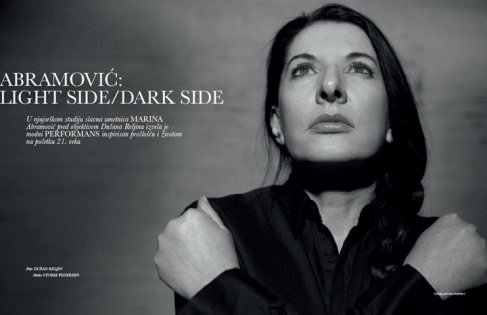
As Sean O.Hagan said in his interview for the Guardian “Like most right-minded people, I reach for my bullshit detector when I hear the term “performance art”. I have no interest in seeing people inflict pain on themselves – and the audience – in the name of art, much less watch them bleed. Abramović, though, is the exception. She cites Josef Beuys and Yves Klein among her inspirations and, to a degree, she has a similar kind of charisma, inspiring a devotion that borders on the obsessive from her legions of fans” http://www.theguardian.com/artanddesign/2010/oct/03/ interview-marina-abramovic-performance-artist and “The Artist is present” is “a masterpiece: so startling and effective, whether you sit with her or not, that it is charisma personified. …Abramovic’s Performances are charisma-based. Not any old charisma will do: you need her charisma…She herself in the MoMA atrium has enough aura for a dozen retrospectives. That face, those eyes, that stage presence, that way of holding herself. …” http://www.artsjournal.com /artopia/2010/03/marina_abramovic_prisoner_of_c.html
https://en.wikipedia.org/wiki/Marina_Abramovi%C4%87
http://www.serpentinegalleries.org/exhibitions-events/marina-abramovi%C4%87-512-hours
Marina Abramović: 512 Hours is at The Serpentine Gallery, London W2, from 11 June to 25 August.
http://www.serpentinegalleries.org/exhibitions-events/marina-midnight-serpentine-diaries
https://www.artsy.net/artist/marina-abramovic-1?institution=serpentine-galleries
http://www.theguardian.com/artanddesign/2010/oct/03/interview-marina-abramovic-performance-artist
http://inhalemag.com/marina-abramovic-generator-sean-kelly/
http://zoowithoutanimals.com/2013/11/18/nude-with-skeleton/ and http://abramovic.garageccc.com
http://www.artsjournal.com/artopia/2010/03/marina_abramovic_prisoner_of_c.html
an_art_made_of_trust_vulnerability_and_connection?language=en
http://www.theartstory.org/artist-abramovic-marina.
http://www.mai-hudson.org/about-mai/
https://en.wikipedia.org/wiki/Marina_Abramović_Institute
https://www.facebook.com/MAIhudson/
